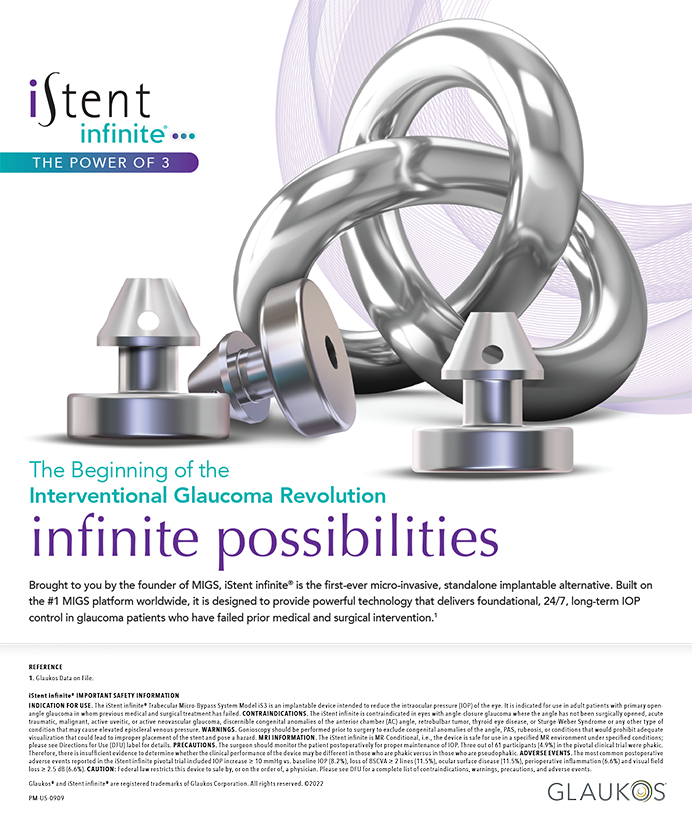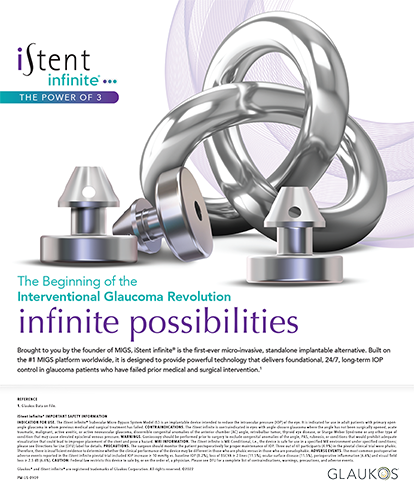A healthy 33-year-old man with no prior ocular history was referred to me for a 6-week history of markedly reduced vision in his left eye. He did not recall the exact time of onset and specifically denied any ocular trauma. What ensued was unexpected.
CASE PRESENTATION
On examination, the patient’s UCVA was 20/15 in his right eye and hand motion in his left. Slit-lamp and fundus examinations of his right eye were unremarkable. His left eye had a quiet, white globe with a clear cornea but a small, 1-mm, healed, shelved corneal laceration below the corneal dome with scarring of an indeterminate age. The anterior chamber was deep and free of cells, the iris was normal with no transillumination defects, and the lens was white with an apparently smooth and intact anterior capsule.
Although B-scan ultrasound prior to referral had reportedly found no abnormalities, I had a second B-scan performed, as is my custom. The study confirmed no evidence of posterior segment abnormalities, but it also showed an intumescent contour to the crystalline lens and a focal echo density with a possible echo shadow behind it (Figure 1).
Ultrasound biomicroscopy demonstrated an intralenticular foreign body near the posterior aspect of the 6.25-mm-thick lens. The posterior contour looked grossly uniform. Although unlikely, a posterior capsular extension of the foreign body could not be excluded, despite multiple angles of view.
CHALLENGES
Recognition of this previously occult intraocular foreign body put me ahead of the game. Nonetheless, a case like this one presents several challenges. First, with a young patient and a markedly intumescent lens, I could presume there would be a high intralenticular pressure and there would be an elevated risk of an Argentinian flag sign, with extension of an anterior capsular opening around to the posterior capsule. Second, I knew there must be an anterior capsular opening, but its location was unknown. Third, I knew there might be a posterior capsular opening.
From a prognostic perspective, I did not know the nature of the material. Although infection was unlikely, even with possible organic material, given the (at least) 6-week time lag without inflammation, foreign bodies containing copper or iron can cause retinal toxicity.
SURGICAL COURSE
I began the case by instilling trypan blue into the anterior chamber and was careful not to deepen or shallow the anterior chamber during this step. Shallowing of the chamber could cause the known but undisclosed anterior capsular tear to widen or extend equatorially. Overdeepening the chamber could increase tension on the posterior zonules and cause an extension of a posterior capsular tear, if one were present. Similarly, once the capsule was adequately stained, I pressurized (not overly so) the anterior chamber by instilling an ophthalmic viscosurgical device (OVD). I presumed that small, linear, diminished staining of the capsule was where the foreign body had entered the lens.
Because the endolenticular pressure was high, I used a 25-gauge needle to decompress the capsular bag by placing its tip bevel down through the center of the capsule and immediately withdrawing soft, liquid cortex. Next, I created a continuous circular capsulorhexis that incorporated the faintly stained, “healed” capsular breech. I eschewed hydrodissection, owing to the unknown status of the posterior capsule.
Considering the imprecisely known location of the foreign body within the lens, I used a dry, manual aspiration technique under an OVD to remove the soft lens material and added viscoelastic as lens material was removed. Once the foreign body was exposed, it was grasped and extracted from the eye (Figure 2). I continued dry aspiration until I could visualize the underlying capsule and confirm that it was intact. Automated aspiration and irrigation completed the lens’ removal, after which I polished the capsule. I implanted a single-piece acrylic IOL in the capsular bag, hydrated the wound, and confirmed a watertight seal. I sent the whitish-grey foreign body for pathologic evaluation to determine whether or not it was ferromagnetic. Its appearance precluded a copper origin.
OUTCOME
One week postoperatively, the patient’s UCVA returned to 20/20 distance and J3 at near.
Had I not known about the foreign body, intraocular maneuvers during the surgery, including the ultrasound tip’s encountering a piece of metal and sending it into the posterior segment, could have resulted in a less happy outcome. Although it is possible that this patient was never aware of the injury, I have encountered many cases in which patients were less than candid about the circumstances surrounding the evolution of their pathology. I recall one instance in which disclosure was withheld because the injury occurred during illegal activities and another case in which the patient’s companion in the room had caused the injury. It is not hard to imagine numerous scenarios in which patients might unconsciously suppress the true history or frankly choose not to reveal that information.
CONCLUSION
Ophthalmologists must be vigilant for signs of injury (eg, penetrating scars) and carefully perform gonioscopy in cases of asymmetric cataract. Angle recession can signal other pitfalls such as zonulopathy or a postoperative rise in pressure.
Michael E. Snyder, MD, is on the Board of Directors at Cincinnati Eye Institute and is volunteer faculty at the University of Cincinnati. Dr. Snyder may be reached at (513) 984-5133; msnyder@cincinnatieye.com.


